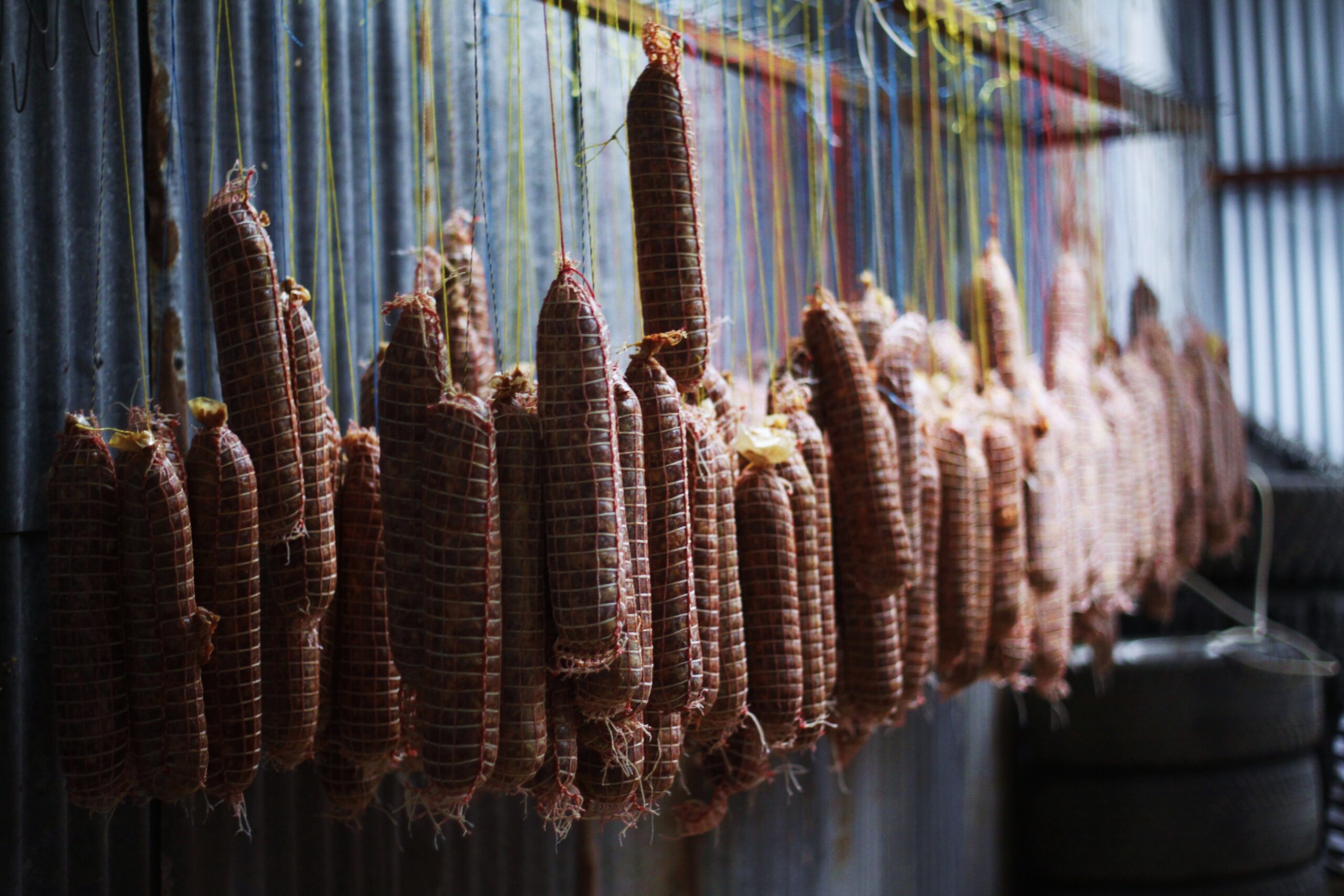Original Photos by Arron Ollington
To many of us, salami is as crucial to the pre-dinner antipasto platter as a good slab of creamy D’affinois might be, or a sweet quenelle of quince paste.
Of course, we’re used to buying this delicious salty cured meatstuff from our local deli; so perhaps less common knowledge is that come winter, a salumi phenomenon takes place every year in garages and home cellars across the country.
Generally, home salami-making isn’t about producing the cured meat for commercial use. It’s just about feeding the family, having fun and making delicious food from scratch. Perhaps most of all, it’s about upholding family traditions; and for some, creating new ones.
For both Eminence Wines owner Clare Burder, and Co-Director of Assemble Giuseppe Demaio, salami making is an excuse to get the friends and family together to have a good time.
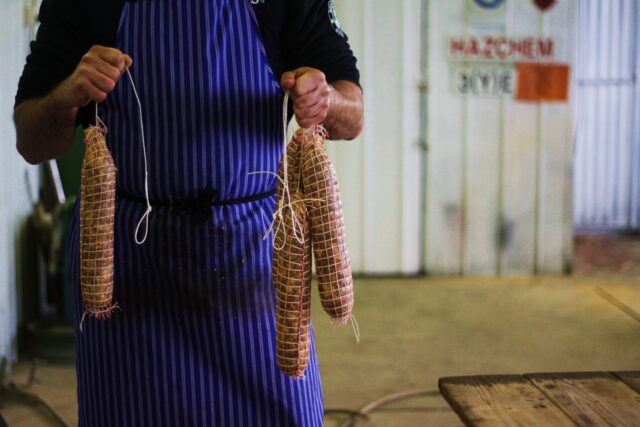
Homemade salami is very much steeped in the traditions of regional Italy. However, for Burder and her family, whose background is Australian and Maltese, making salami has grown into a favourite pastime regardless of the lack of Italian blood.
Burder’s family owns a high plateau winery in the isolated Whitlands region – a stable, cool environment which lends itself well to hanging sausages and salami. Her brother is an avid hunter with licence to shoot deer on the property, which is why they began making venison sausages.
“We didn’t like leaving the carcasses around, so my brother started using the meat,” Burder says. “It was a natural progression from sausages to salami, as they both require the same equipment.”
While the family isn’t Italian, per se, the King Valley region’s prevalent Italian culture had a significant influence on the Burders. “I guess it was just sort of hanging around all these people that make salami and then giving it a crack ourselves,” Burder says. “Dad’s good friend Wally is from northern Italy and he taught us the northern Italian style of making salami, which means we don’t use any smoke and we use a narrow casing.”
While they initially kept salami-making within the family, it wasn’t long before Burder’s friends started jumping on board. “It escalated really quickly; one year it was a couple of pig’s legs and a few of us, and now it’s three pigs and sixteen people. The process takes a whole day, everyone brings wine and food and we have a great time!”
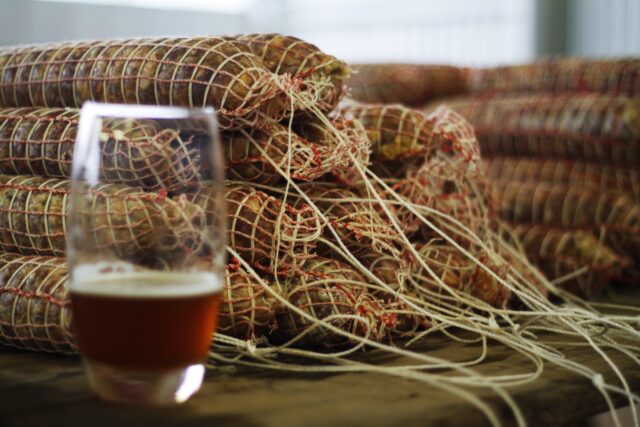
While Burder’s enthusiasm and passion for salami is certainly infectious, it is lovely to chat to Demaio about his experiences steeped in family traditions traced back to Southern Italy.
Demaio runs Assemble, a company that produces art and design publication Assemble Papers, and creates small footprint projects that are focused on sustainability and human-centred design.
Perhaps Demaio’s interest in community and sustainability stemmed from his family’s love of slow food and family tradition, driven by his father Pietro Demaio.
While Demaio’s father is a doctor by trade, it was his avid interest in keeping his family’s Italian food culture alive that drove him to self-publish the book Preserving The Italian Way in the early 2000s. “Dad started documenting the recipes about 20 years ago because he was kind of worried they were going to get lost,” Demaio says. “It was pre-food frenzy, so there wasn’t this real interest in the whole slow food movement which has gone bananas over the last ten years. He was concerned all those great recipes, and all the stories that go along with them, would be lost.”
Demaio’s father started collating recipes for many different Italian foods, including salami. “Like every tradition, every family had their different way of doing it, their own recipe,” Demaio says. “They were always a little bit secretive of what the magic ingredient was, and in the old days, that was always a fun part of it.”
Demaio says that back then, the younger generation weren’t as interested in the recipes as they might be now, given that food has become such a fashionable part of culture. “These recipes that are kind of family heirlooms were in danger of not getting passed on.”
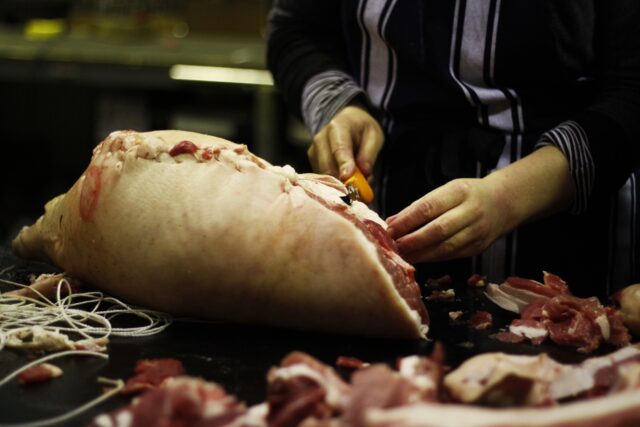
Demaio says there is no risk of that occurring now, given that he and his siblings have taken more of an interest in these family traditions as they grow older. “I don’t know if it’s just because I’m not 20 anymore, but I’m taking more of an interest in my parents and family and their backgrounds generally. As an adult, you really enjoy spending time with your family,” Demaio says.
“It’s that connection to culture that’s the nice thing about it; keeping that link. Migrants moved out here in the 50s, and I think [making food together] was a way for them to stay connected with Italy, and to gather the Italian community together. Now, two generations on, we’re still keeping that connection.
“It’s also just a great way of having an enjoyable day with your friends and family, with some good food to go with it. And [after you’ve made the salami] there’s nothing like getting some baguettes, firing up a few of the fresh sausages on the barbecue and sampling the goodies.”
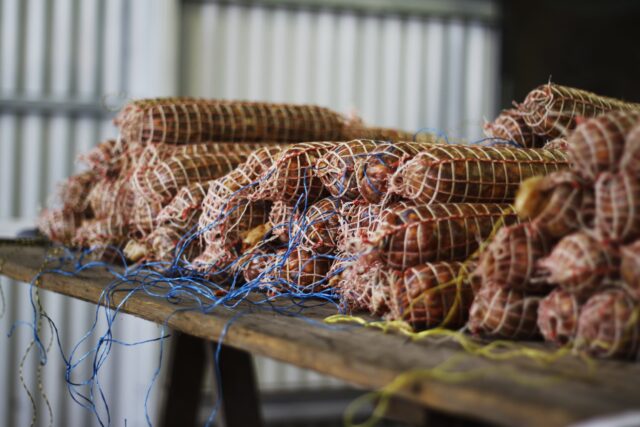
Demaio says there’s no doubt that the process of making salami, along with other traditional Italian foods, has helped him to better appreciate food and where it comes from.
“Growing up with my family, I’ve always had a connection with food and what it takes to create it,” Demaio says. “Not just salami, but with a veggie patch, [for example] – you know that you are going to get around 10kgs of home grown tomatoes a year, and they’re going to be the most delicious tomatoes you ever eat. Salamis are similar. They’re precious; so you savour them quite a bit. We also bring them to people as presents; that’s quite a tradition too. And an Italian boy never goes to someone’s house without bringing something.”
Similarly, Burder says it’s really important for people to know what goes into their food and where their food comes from.
“I think there’s something really fundamental to the way we live in terms of [this kind of process],” Burder says. “Like winemaking, making salami connects you with the land, it connects you with the product. It’s a group thing so there’s a social aspect, and there’s the idea of working together to make something really cool. And there’s that beautiful chaos at the end where we all get to eat delicious salami. Any activity that results in a tangible product is good for the soul. So that, and getting a bit dirty and doing a bit of fun work is where the appeal is.
“Making salami at home is awesome, trying to unravel a little bit of the mystery while gaining huge bragging rights in the process. While I’m a winemaker and I get used to saying “I made this” about products, for a lot of people, they don’t get to say that about their work. So for them, it’s really satisfying.”
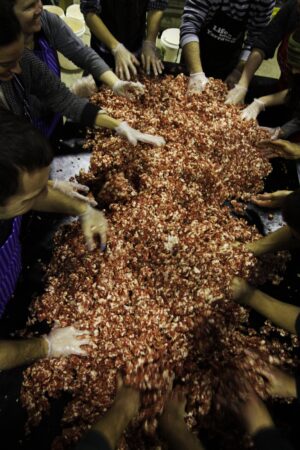
How to make homemade salami
Neither Demaio nor Burder’s family sell the salami they make commercially given the rigidity of the law around the industry. For both, it’s purely for the enjoyment. “Making a meat product is a very highly regulated business, so in order to sell salami you need to make it in a certified facility, a commercial kitchen [that incorporates] many rules you need to adhere to. That’s why we just make it for us to eat,” Burder says.
“With three pigs, we end up getting about 18 sticks of salami to take home each, which is about a year’s worth.”
Like Burder, Demaio and his friends and family spend a couple of days down the Peninsula to uphold the family tradition. “We’ll get some meat to cure and head down the Peninsula. That’s when you have to think about what kind of space you have for the salami to cure in as well,” Demaio says. “We’ve got a cellar, which has relatively stable curing conditions for the salami. Optimal curing conditions are about 13 to 14 degrees, with around 70-80 per cent humidity so they don’t dry out too quickly.”
Burder says salami-making is basically one step further than making regular sausages. “You make a big batch of mince, you’ll add your flavouring. We do three flavours: a plain one, a fennel and a chilli. And from three pigs we get about 280, 800g salamis.
“There’s different ways you can cure meat; you can smoke it, you can cure it with salt, you can dry it. But salami is a salt cure. So you have to break down the carcasses and cut the fat off to use later, but we need the meat and the fat to be separate. So the first part requires everyone pulling the pigs to bits, taking the bones out, and separating all the fat from the meat. Then we mince everything and weigh everything.”
Burder says that once everything is weighed, it’s important to get the ratios of fat, meat and salt right in the mix. “It needs to be 30 per cent fat and then we want three per cent salt,” Burder says. “The salt is particularly important, because if you add too much salt to the meat, it’s too salty; but if you don’t add enough, you run the risk of the salami going off.”
Burder says this is different to other cured meats; for example, making prosciutto. “For prosciutto, you have to soak the whole leg in salt and then wait until the salt penetrates the meat that way; whereas with salami, the salt is already mixed into the mince,” Burder says. “So it’s actually a really safe method of curing as a result.”
After everyone gets elbow-deep in mixing the mince together, Burder and crew hang up the sausages. “They go into casings, and then into nets, and they’re hung up in our little salami curing room for about 11 weeks,” Burder says. “In about five or six weeks, they go really, really mouldy, but it’s a good mould, kind of like cheese mould. That mould gives the salami all the flavour and also actually stabilises the salami chemically. Then we wash all the mould off and we re-hang them, and they go mouldy again. After about eleven weeks, we pull the skins off and then cryovac them (which is sealing the salami in air-tight bags). They’ll last a year like that.”
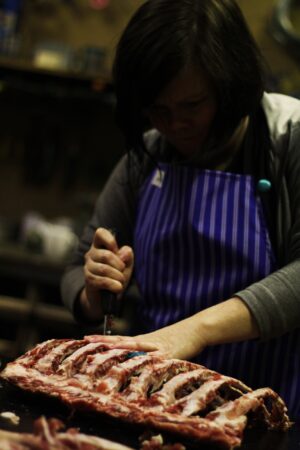
Burder says some people might feel squeamish about what goes on behind the scenes in the salami-making process. “It seems a bit counter-intuitive in one way, like, ‘oh, I’m eating really old meat’. Sounds gross, right? But it’s actually delicious,” Burder says.
“We’ve never had any issues, health-wise. We’ve got a good recipe and we don’t use any preservatives. We only use free-range organic pigs, which is really important because we’re making something which only has a few ingredients, so the pork has to be really, really good. There’s no other flavour to hide behind.”
Burder says that despite the involved process, she wouldn’t have it any other way and gets excited about every salami-making event she hosts. “With around 16 people coming up and getting involved, it’s a bit of a mission. But god it’s fun… it’s the best weekend of the year!”

